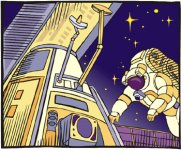
Worksheets and No Prep Teaching Resources
Reading Comprehension Worksheets
Transportation

Transportation
 Worksheets and No Prep Teaching Resources Reading Comprehension Worksheets Transportation |
 Transportation |
| edHelper's suggested reading level: | grades 7 to 9 | |
| Flesch-Kincaid grade level: | 8.25 |
|
Space Stations
By Trista L. Pollard |

|
 1 The ultimate space dream may be only a few years away. NASA and other major space agencies around the world have been working on the International Space Station (ISS). A space station or space platform is an artificial earth satellite that is placed into orbit with a crew. Think of it as a laboratory floating in space. Once on a space station, scientists can make astronomical observations, process zero gravity materials, and assemble, refuel, and repair satellites. Space stations can also be used as platforms for weapons.
1 The ultimate space dream may be only a few years away. NASA and other major space agencies around the world have been working on the International Space Station (ISS). A space station or space platform is an artificial earth satellite that is placed into orbit with a crew. Think of it as a laboratory floating in space. Once on a space station, scientists can make astronomical observations, process zero gravity materials, and assemble, refuel, and repair satellites. Space stations can also be used as platforms for weapons. |
Create Weekly Reading Books
Prepare for an entire week at once! |
| Leave your feedback on Space Stations (use this link if you found an error in the story) |
 |
Transportation
|
 |
High School Reading Comprehensions and High School Reading Lessons
|